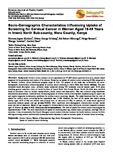| dc.contributor.author | Muthoni, Mutuma Agnes | |
| dc.contributor.author | Ochieng, Otieno George | |
| dc.contributor.author | Mburugu, Kei Robert | |
| dc.contributor.author | Samson, Ndege | |
| dc.contributor.author | Taratisio, Ndwiga | |
| dc.contributor.author | Gacheri, Rose | |
| dc.date.accessioned | 2018-08-15T07:59:23Z | |
| dc.date.accessioned | 2020-02-07T09:20:01Z | |
| dc.date.available | 2018-08-15T07:59:23Z | |
| dc.date.available | 2020-02-07T09:20:01Z | |
| dc.date.issued | 2016 | |
| dc.identifier.uri | http://repository.must.ac.ke/handle/123456789/1345 | |
| dc.description.abstract | Cervical cancer continues to kill approximately 274 ,883 women globally every year, despite robust programs for the prevention and control of the disease. Kenya has an uptake of cervical cancer screening (3.2%) compared to the National Cervical Cancer Prevention program tar get of 70%. The purpose of this study was to determine the socio- demographic characteristics influencing uptake of cervical cancer screening in Imenti North Sub-County. This was institution-based descriptive cross- sectional study conducted among 422 randomly selected women aged 18-49 years attending general outpatient clinics in health facilities of Imenti North Sub-County, Kenya. Health Facilities were stratified
based on functional levels to include county referral, health centers and dispensaries. Data was collected using interviewer
administered questionnaire Characteristics influencing uptake of cervical cancer screening were analyzed using chi-square test and logistic regression to determine predictors for cervical cancer screening. The study found out that the level of
uptake for cervical cancer screening by the respondents was 15.2%. However, the level of the uptake was lowest among
women aged 18-25 (4.4%) and women with primary level of education (11.6%). In addition, the study found significant
association between uptake and age (p-value<0.001). Other significant socio-demographic characteristics
include marital status and level of education. Women in age category 42-49 years were 6 times more likely to be screened compared to women aged 18-25 years (p-value=0.022) The level of uptake for cervical cancer screening by the respondents was 15.2%. The main determinants of uptake of screening were age, marital status, occupation, and high level of education. It was recommended that Health Managers should conduct refresher seminars for health workers, increase facilities offering screening services and intensify community health education in order to increase uptake of cervical cancer screening. | en_US |
| dc.language.iso | en | en_US |
| dc.publisher | Science Publishing Group | en_US |
| dc.subject | Cervical Cancer, | en_US |
| dc.subject | Women of Reproductive Age, | en_US |
| dc.subject | Socio-D emographic Characteristics, | en_US |
| dc.subject | Uptake of Cervical Cancer Screening. | en_US |
| dc.title | Socio-demographic characteristics influencing uptake of screening for cervical cancer in women aged 18-49 years in Imenti north sub-county, Meru County, Kenya | en_US |
| dc.type | Article | en_US |

